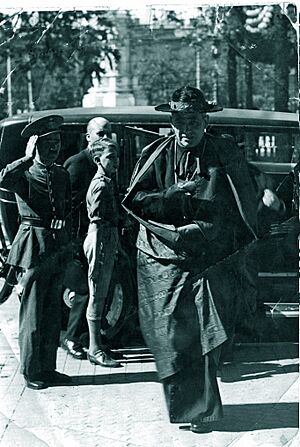Pedro Segura y Sáenz facts for kids
Quick facts for kids Pedro Segura y Sáenz |
|
|---|---|
| Archbishop of Seville | |

Cardinal Segura in 1939.
|
|
| Church | Roman Catholic Church |
| Archdiocese | Seville |
| See | Seville |
| Appointed | 14 September 1937 |
| Enthroned | 2 October 1937 |
| Reign ended | 8 April 1957 |
| Predecessor | Eustaquio Ilundáin y Esteban |
| Successor | José María Bueno y Monreal |
| Other posts | Cardinal-Priest of Santa Maria in Trastevere (1929–57) |
| Orders | |
| Ordination | 9 June 1906 |
| Consecration | 13 June 1916 by José María Cos y Macho |
| Created Cardinal | 19 December 1927 |
| Rank | Cardinal-Priest |
| Personal details | |
| Birth name | Pedro Segura y Sáenz |
| Born | 4 December 1880 Carazo, Osma, Kingdom of Spain |
| Died | 8 April 1957 (aged 76) Nuestra Señora del Rosario hospital, Madrid, Francoist Spain |
| Parents | Santiago Segura y Arroyo Juliana Sáenz y Camarero |
| Previous post |
|
| Motto | Solo virtud es nobleza (Only virtue is nobility) |
| Coat of arms |  |
| Styles of Pedro Segura y Sáenz |
|
|---|---|
 |
|
| Reference style | His Eminence |
| Spoken style | Your Eminence |
| Informal style | Cardinal |
| See | Seville |
Pedro Segura y Sáenz (born December 4, 1880 – died April 8, 1957) was an important leader in the Roman Catholic Church in Spain. He became a Cardinal, which is a very high rank. He served as the Archbishop of Toledo from 1927 to 1931. Later, he was the Archbishop of Seville from 1937 to 1954. He was made a Cardinal in 1927.
Contents
Early Life and Education
Pedro Segura y Sáenz was born in Carazo, Spain, in 1880. He began his journey to become a priest by attending the seminary in Burgos. He also studied at the Pontifical University of Comillas.
On June 9, 1906, he was ordained as a priest. After this, he worked in churches in Burgos. He also taught at the seminary there.
Becoming a Bishop and Archbishop
In 1912, Pedro Segura became a professor at the Pontifical University of Valladolid. He was also in charge of studies there. He held other important roles within the church in Valladolid.
On March 14, 1916, he was chosen to be the Auxiliary Bishop of Valladolid. He was also given the title of Titular Bishop of Apollonia. He officially became a bishop on June 13, 1916.
He then became the Bishop of Coria on July 10, 1920. Later, on December 20, 1926, he was promoted to Archbishop of Burgos.
Serving as Archbishop of Toledo
On December 19, 1927, Pope Pius XI named Pedro Segura the Archbishop of Toledo. This was a very important position because the Archbishop of Toledo is also known as the Primate of Spain. This means he was the highest-ranking bishop in Spain.
That same year, Pope Pius XI made him a Cardinal-Priest. This happened during a special ceremony called a consistory. Since he couldn't attend the ceremony, he later received his special red hat from the Pope on October 28, 1929.
Challenges and Exile
In July 1931, Spain was going through big political changes. The new government, called the Republican government, sent Cardinal Segura into exile in France. He had openly disagreed with this new government and supported the idea of a king ruling Spain.
He resigned from his role as Archbishop of Toledo on September 26, 1931.
Archbishop of Seville and Later Years
On September 14, 1937, Cardinal Segura became the Archbishop of Seville. This happened after the previous Cardinal, Eustaquio Ilundain y Esteban, passed away.
In 1939, Cardinal Segura was one of the cardinals who helped choose the new Pope. This meeting, called a papal conclave, selected Pope Pius XII.
Cardinal Segura was known for his very traditional views. He believed strongly in the teachings of the Church. He also thought that the Church and the government should not be separate. He was against different religions being seen as equal. He also had strict views on things like attending movies and dances, which he did not allow for Catholics in Seville. He also did not support women getting the right to vote.
Towards the end of his time as Archbishop of Seville, there were some disagreements. In November 1954, the Vatican asked him to leave his position. He did not want to leave the Archbishop's Mansion at first, and police had to help with his removal.
Cardinal Segura passed away in Madrid on April 8, 1957, at the age of 76. He was buried in Cerro del Sagrado Corazón.
See also
 In Spanish: Pedro Segura para niños
In Spanish: Pedro Segura para niños


